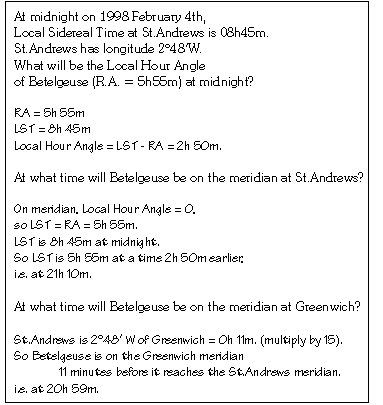
Consider the rotation of the Earth relative to the stars. We define one rotation of Earth as one sidereal day, divided into 24 sidereal hours each of 60 sidereal minutes, etc. It is measured as the time between two successive meridian passages of the same star.
Define Local Sidereal Time (LST) to be 0 hours when the vernal equinox is on the observer's local meridian.
One hour later, the local Hour Angle of the equinox is
+1h (by the definition of Hour Angle), and the Local Sidereal Time is 1h.
So at any instant, LST = LHA(vernal equinox).
Alternative definition: suppose that LST = 1h. The equinox
has moved 15° (1h) west of the meridian, and some other star X is now
on the meridian.
The RA of star X = the angular distance from the equinox to X = 1h = LST.
So at any instant, LST = RA(stars on meridian).
Observers to east or west will have different stars on
their local meridians.
Define Greenwich Hour Angle of X as the Hour Angle of X relative
to the celestial meridian at Greenwich.
Then define Greenwich Sidereal Time (GST) as the Greenwich Hour
Angle of the vernal equinox.
LST = GST - longitude west.
Local Hour Angle of star = Local Sidereal Time - RA of star.
Greenwich Hour Angle of star = Greenwich Sidereal Time - RA of star.
Consequently, LHA = GHA - longitude west.

Return to index.